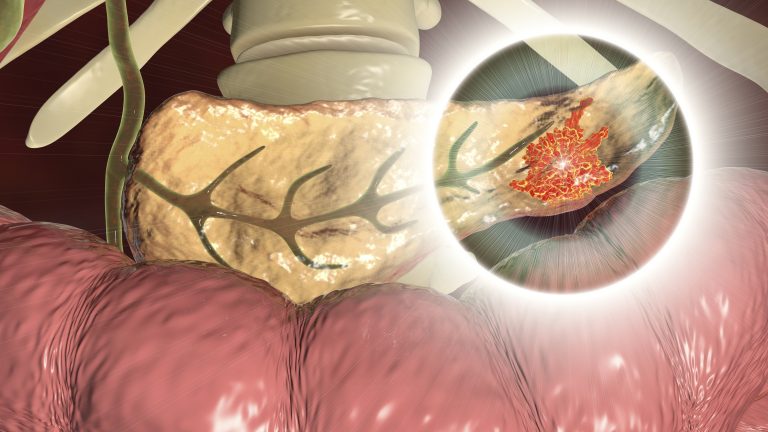
Tumor size has a strong impact on survival rates of patients with pancreatic cancer (PC), which are some of the worst of all cancer with a five-year survival rate of only 10%. The larger the tumor, the less likely it is to be cured by resection. There have been cases, however, where large tumors have been removed by surgery—and now there may be added hope. A preclinical study from the lab of Marsha Moses, Ph.D., at Boston Children’s Hospital, reports marked and lasting tumor regression in a mouse model, using a highly selective, engineered antibody-drug combination.
The findings, “A Rationally Designed ICAM1 Antibody Drug Conjugate for Pancreatic Cancer,” were published in the journal Science Advances.
The poor prognosis and survival rates still stand despite the recent applications of immunotherapy and nanomedicine therapy. The poor results are largely due to the tumor microenvironment of pancreatic cancer tumors. The tumors have a limited blood supply, making it hard to deliver drugs, surrounded by a dense connective tissue called stroma, and protected by an extracellular matrix.
The researchers sought to develop novel targeted therapeutics that can better access PC tumors while maintaining potent tumor‐specific efficacy.
“It can be difficult to get drugs into these tumors,” stated Moses, who directs the vascular biology program at Boston Children’s. “We developed a novel chemo-immunotherapy agent that selectively recognizes and penetrates pancreatic tumors better than other therapeutics.”
Led by Jing Huang, Ph.D., the Moses lab developed an antibody-drug conjugate (ADC). “ADCs are a rapidly growing class of targeted therapeutics that have shown promising clinical efficacy against several types of cancers including aggressive solid tumors such as breast cancer that respond poorly to T‐cell immunotherapy. Unlike conventional chemotherapeutics, ADCs utilize chemical linkers to conjugate cytotoxic drugs to tumor‐homing antibodies which are capable of selectively targeting the tumor while sparing normal tissues,” noted the researchers.
The researchers developed an ADC with two components: an antibody that selectively homes to a molecule on the surface of pancreatic cancer cells, known as ICAM1, and a drug toxic to cancer cells. Cells bearing ICAM1 on their surface are killed by the drug, while normal cells are spared.
“The size of the ADC is similar to the size of a single antibody: less than 10 nanometers,” explained Peng Guo, PhD, of the Moses Lab, and co-corresponding author on the paper with Moses. “Because of this ultra-small diameter, it can penetrate the stroma and reach pancreatic tumor cells better than other novel treatments such as T-cell immunotherapy or nanomedicines.”
In 2014, the Moses lab showed high levels of ICAM1 on triple-negative breast cancers, and that it is abundant on melanoma and thyroid cancers as well. The researchers performed an unbiased screening to select the best drug to include in the ADC. They test four candidates and found the DM1-ICAM1 antibody combination did not harm non-cancerous pancreatic cells which do not produce ICAM-1.
The researchers found that mice receiving the DM1-ICAM1 antibody conjugate had a reduction in tumor size that persisted during the 14-week study, even after just two doses. They also found the treatment inhibited metastasis to normal organs including lung, liver, and spleen.
Huang then developed an MRI-based molecular tumor imaging technique to complement ICAM1 ADC therapy, to confirm the presence of ICAM1 on the tumor without the need for an invasive biopsy. This technique could potentially help to predict the treatment’s effect and monitor changes over time.
Eventually, Moses hopes to be able to monitor the treatment effect using two non-invasive urinary biomarkers previously reported by the team.
While other ADCs have been tested in pancreatic cancer, none have shown sufficient efficacy in the clinic and have also resulted in off-target toxicity, noted Moses. “The precision of our approach comes from both the specific targeting and the ability to monitor that targeting with MRI,” she said.
Their findings provide a basis for further preclinical studies and may one day lead to this approach being used in the clinic.













